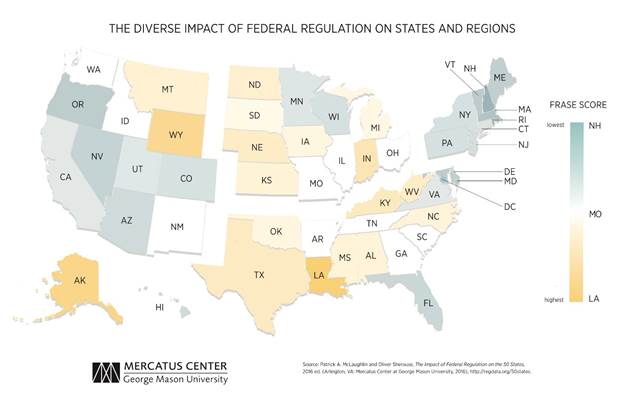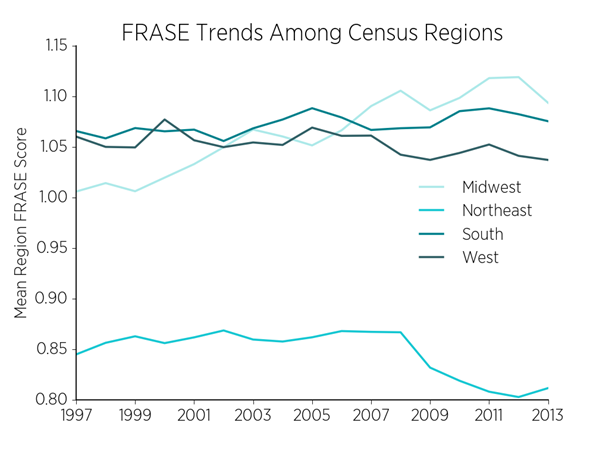- | Regulation Regulation
- | Expert Commentary Expert Commentary
- |
The Persistence of Regionalism in Federal Regulations
Even if the different regional and state impacts of new regulatory policies are not deliberate design features, the fact remains that some areas feel more impact than others.
Regional protectionism in regulatory policy was a term used several decades ago to describe the regional effects built into regulatory acts of Congress. At the time, Brookings Institution economist Robert Crandall and University of Chicago economist Peter Pashigian looked at the regional distribution of congressional support for specific elements of the Clean Air Act that would discourage the development of production facilities in the South and the West. Their studies showed that support came largely from high-income, low-growth states in the North and from urban and industrialized congressional districts in the North and Northeast.
Two salutary lessons that their scholarship exposed remain true today: First, regulations affect different regions differently, which alters the distribution of economic growth across regions. Second, the different impacts on different regions can be a deliberate design feature.
Early regulations on sulfur dioxide emissions specified that new industrial sources of pollutants — such as coal-fired power plants — would be required to install devices that would achieve the maximum possible percentage reduction in emissions, regardless of the actual level of emissions. The level can vary tremendously depending on the sulfur content of the coal used. For example, in Kentucky, West Virginia and other Appalachian states, coal is relatively abundant but also has a higher sulfur content than coal from many Western states. By requiring a focus on design, rather than performance, these regulations made the construction of new plants much costlier and thereby discouraged the migration of producers away from the North and Northeast to less developed and otherwise lower cost regions. While some may argue that regional differences are both inevitable in federal regulation and worthwhile, so long as the policy objective is achieved, Crandall found it telling that Congress "seemed uninterested" in assessing whether its regulatory policy actually was affecting air quality.
Those policies have evolved since then, and surely we have learned our lesson. Or have we? My colleague Oliver Sherouse and I recently released a study that estimates the different impact of federal regulation on each state and the various regions of the country. We constructed a new index, called the Federal Regulation and State Enterprise (FRASE) index, that weights the incidence of federal regulation on each industry in the economy by the relative importance of those industries to each state. While we expected to find different impacts across the states, we were somewhat surprised to see that regional protectionism still appears to be a prominent feature of federal regulation, as the following "heat map" of our index suggests:

This heat map is color coded to show impact relative to the national average. The "hotter" states, shaded in orange, are more impacted by federal regulation, while the "cooler" blue colors indicate states less impacted than the national average in the same year. The Northeast region, which played such a prominent role in Crandall's and Pashigian's analyses, stands out from the others because every single state is less impacted than the average.
Furthermore, the regional differences appear fairly persistent over the time period for which we had data. The nearby figure compares the FRASE index scores for the four regions of the United States. As the 2013 heat map indicates, important industries in the Northeast experience a lower incidence of federal regulation compared to those of other regions, and this remained true from 1997 to 2013. It also reveals that the Midwest has moved up in the rankings of regions. In 1997, it was the third least impacted of the four regions. By 2013, it had taken over the top spot.

Our index takes into account both the incidence of federal regulation on specific industries and the importance of industries in each state. That means some of the changes in regional impact is driven by the growth or decline of industry importance, while some of it is driven by changes in regulation. Of course, these two factors are not independent — policies that change the regulatory landscape for industries can lead to changes in those industries' economic importance. The FRASE index offers a way to understand and visualize the interaction of these forces over time and their implications for the unique mix of industries in each state and region.
Regional protectionism in regulatory policies was identified by Crandall and Pashigian nearly 40 years ago. New trends in regulation, driven by Congress's responses to events of the past two decades, are beginning to take shape as well, and they are certain to also have different impacts on different states and regions. The Dodd-Frank Act and the Affordable Care Act are both major regulatory acts that are likely to transform the economic outlook of several industries and the economy overall. For example, in New York, where financial services account for a substantial portion of the state's economy, the regulatory impact of Dodd-Frank is already evident, and the trend toward more financial regulation is unlikely to stop anytime soon.
Even if the different regional and state impacts of new regulatory policies are not deliberate design features, the fact remains that some areas feel more impact than others. The same logic applies now as 40 years ago: Given that federal regulations affect the distribution of economic growth and overall growth rate in the country, shouldn't Congress at least verify that its regulatory policies are achieving their intended outcomes?